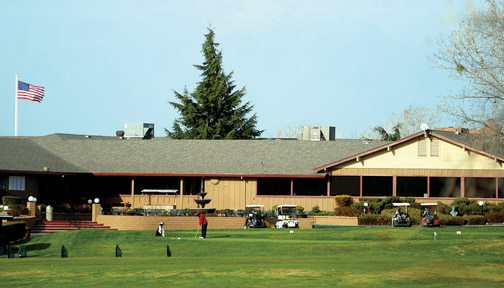The golf business has been stuck in the rough for several years now, with few signs of getting back onto the fairway anytime soon.
“I think the golf industry is still a good four to five years away from the road to recovery,” said Bruce Lewis, the director of golf at Ridgemark Golf and Country Club. “I’ve seen some improvement, but we’re not through (the downturn) or even close to getting out of it by any means.”
“We don’t know where the bottom is in golf,” Dick’s Sporting Goods CEO Ed Stack said in the Pittsburgh Business Times. “You’ve got to bottom out before sales start increasing again. The industry has a real issue.”
More like a crisis and riddle combined into one.
Locally and nationally, sales at golf stores are down, and golf courses have seen a precipitous drop in revenue. There are a variety of factors that have contributed to golf’s downturn—a lack of disposable income and the fact that fewer golfers are playing and even the ones who do play are playing less are issues that loom near the forefront—but the most prominent one to club pros revolve around a cultural shift.
“The family culture has really changed in the last two generations,” Lewis said. “Before dad played a full 18 holes either on Saturday or Sunday, or sometimes both days. But now dad is going to his kids’ games and is more busy and involved in the family aspect of things.”
Manny Freitas, the director of golf at San Juan Oaks Golf Club, agreed: “It’s harder for a man in the family to get away for a round of golf because they have kids in multiple sports. So they’re busy taking their kids to games and watching their games.”
Simply put, the sooner golf can find a way to appeal to families and women in particular, the faster the sport will recover. To that end, the PGA of America and the entire golfing community in general have to find ways to make golf more attractive to families in general.
Since there are more activities today competing for a family’s entertainment dollar, golf needs to make the game stand out more so than it has in the past.
“The way we ran golf for decades just doesn’t work anymore,” Lewis said. “We need to reach out and ask people, ‘How can I help you find a tee time?’ It’s a different philosophy of operations.”
Said Freitas: “Our job as golf pros is to grow the game. We’re kind of in a grassroots campaign to get the game growing again.”
The problem is that fewer golfers are taking the course. Last year, 650,000 U.S. men quit golfing, according to the National Golf Foundation. U.S. courses hosted 462 million rounds in 2013, the fewest they’ve logged in almost 20 years.
“The PGA of America knows it’s a big problem because not enough new players are coming into the game,” Freitas said. “The game isn’t growing (to support) the amount of golf courses that are out there, so there’s a supply and demand issue. It’s not just a national problem, but it’s a global problem.”
With green fees being the main source of revenue for most clubs, it’s incumbent for the industry to get more people taking up the game. Lewis said the number of rounds played at Ridgemark is actually up in the last year or so, but revenue is down since courses have had to offer more deals due to competition.
“There’s no longer the loyalty to the one or two golf courses a typical golfer might play,” Lewis said. “The loyalty is to who has the cheapest ad in this week’s paper or who has the cheapest deal online. There are more bargain hunters. We’re not bringing in the dollar per round we used to, and in general the player who used to play five times a week is now playing only two to three times a week.”
Just like any other sport, golf has to compete with other sports and activities for a family’s time and their disposable income.
“Disposable income is down, and now there are more options and ways for families to spend their disposable income,” Freitas said.
“When things tighten up financially, golf is one of the first things to go,” Lewis said.
The problems are vast and the solutions are unclear, and that’s why it’s vital for the golf industry to start changing with the times. Lewis thinks there will be more rounds played on nine-hole courses in the coming years, as more golfers are unwilling to either spend an entire day out on the course or the green fees to play 18 holes.
The downsizing of courses has already started to take place locally, as Ridgemark was slated to go from 36 holes to 18 as of Tuesday.
“We’re going to take holes from each course and come up with a new combination,” Lewis said. “We couldn’t keep 36 holes open for the quality of play golfers want. I’m a golf professional, and I didn’t want any holes to close. It’s a hard pill to swallow. This is a tough time and a not a pleasant thing to go through.”
Make no mistake: The golf industry is at a critical juncture, and is in the midst of its longest downturn ever. But Lewis sees hope on the horizon, as long as the people in charge of the game make the correct decisions.
“All of the professional and amateur associations need to work together to get good ideas for the game,” he said. “We don’t care who gets the good idea—let’s just get the good idea to turn our game around.”










